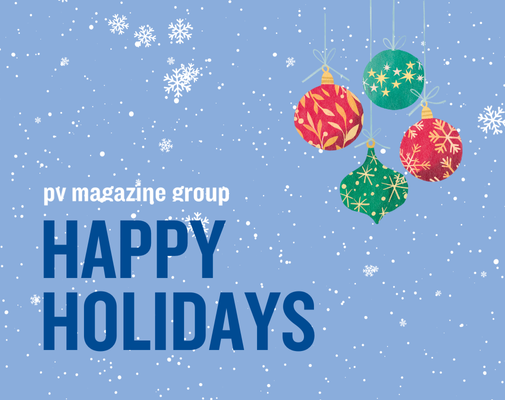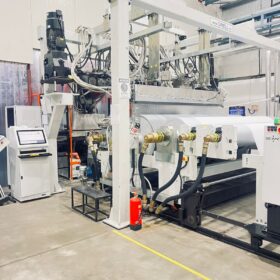Top News
Waaree Transpower secures 1.27 GW inverter duty transformer order from leading solar EPC company

Sachin Tendulkar invests in solar EPC firm Suntek Energy

ArcelorMittal to add 1 GW of solar and hybrid renewable energy capacity in India
The pv magazine team wishes you happy holidays and a wonderful start to the new year!

SunRise Arabia Clean Energy Conference 2026
Join the 3rd SunRise Arabia Clean Energy Conference on April 22, 2026, in Riyadh to explore how solar PV and energy storage are powering the Kingdom’s growing digital economy — including data centers. Secure your spot at the early-bird rate.
Battery Business & Development Forum 2026
Connect with Europe’s energy storage leaders at the Battery Business & Development Forum 2026 in Frankfurt (March 31–April 1) and gain insights into evolving business models, financing strategies, and market trends
Out now - pv magazine Global Winter Edition
The new pv magazine Global edition is out now!
Available in print and digital – get your copy today!

Saatvik Green commissions 2 GW EPE film manufacturing facility, secures INR 486 crore solar module order

Researchers find sodium-ion batteries using hard carbon anodes can intrinsically charge faster
Emmvee starts production at 2.5 GW solar module line in Karnataka
Bondada Engineering secures INR 945.10 crore solar EPC order from NLC India Renewables
Luminous Power Technologies secures 350 MW solar project under PM-KUSUM Scheme
Markets & Policy
Featured
Why Tier-2 and Tier-3 cities will drive India’s next big solar jump
Too much to choose from, too little to decide
Market pressure in the solar and storage sectors often favors low-cost solutions, but long-term success depends on balancing price, quality, and reliability for assets designed to operate for decades. Numerous examples, from low-grade silicon modules to residential hydrogen and redox flow storage, show how technically ambitious products can fail when costs, complexity, or durability are misjudged.
China files WTO complaint against Indian solar subsidies
China’s Ministry of Commerce has raised a complaint at the World Trade Organization (WTO) regarding India’s solar subsidies, claiming they give the country’s domestic industry an unfair advantage and harm Chinese interests.
Waaree Solar Americas invests in polysilicon company
Waaree Solar Americas has entered into a binding term sheet with United Solar Holding Inc. (USH), a Cayman Islands-based company, to invest around $30 million through the subscription of Series B preferred shares. The investment is a strategic move by Waaree to secure a long-term, fully traceable polysilicon supply chain to support its rapidly expanding manufacturing footprint in the U.S. and globally.
TPCL tenders EPC package for 50 MW solar in Sri Lanka, NGEL invites bids for 100 MW agri-PV projects in India
Trincomalee Power Co. Ltd (TPCL), a 50:50 joint venture between Sri Lanka’s Ceylon Electricity Board and India’s NTPC Ltd, has invited bids for the EPC package of a 50 MW (AC), Phase I ground-mounted solar project at Sampoor, Sri Lanka, while NTPC Green Energy Ltd. (NGEL) has floated a separate tender for an EPC package with land to develop cumulative 100 MW agri-PV projects across four Indian states.
Powering India’s digital transformation: The backbone technologies you don’t see
Every new 5G deployment, data centre expansion, or broadband rollout depends on power and cooling architectures that operate quietly in the background, ensuring continuity, efficiency, and resilience.
Installations
Featured
Coal India invites bids for 20 MW floating solar project in Uttar Pradesh
India surpasses 132 GW of installed solar capacity: MNRE
Solar PV capacity addition is led by Rajasthan, which accounts for 27% (36 GW) of the cumulative installed capacity. Gujarat ranks second with 24.8 GW, followed by Maharashtra with 17.2 GW. Together, these three states account for over 58% of India’s total installed solar capacity.
Why EPC leaders must diversify across energy transition and digital infrastructure
The EPC organisations that choose to lead across both the energy transition and digital infrastructure will not simply respond to the coming decades of change, they will shape them.
GEON launches inverter with inbuilt lithium battery for homes
GEON, part of the 60-year-old Kabra Extrusion Technik Group, has launched GELITHIUM, an all-in-one power backup system that integrates a pure sinewave inverter with an inbuilt lithium-ion battery. GELITHIUM is available in 1,250 VA and 2,500 VA variants, with 12.8V/100Ah and 25.6V/100Ah lithium batteries, respectively.
NTPC switches on 359.58 MW solar
NTPC has announced the commercial operation of 359.58 MW of solar capacity across projects of its subsidiaries in Gujarat and Rajasthan, taking the Group’s total commercial capacity to 85.5 GW+.
Bhutan tenders 120 MW solar project
Bhutan’s authorities are seeking a developer to design, supply, install, test and commission a 120 MW solar farm. The deadline for applications is Jan. 26, 2026.
Technology
Featured
The Hydrogen Stream: IIT Kanpur, HBTU to jointly establish Centre of Excellence for Green Hydrogen in Uttar Pradesh
The future of impact funding: Aligning capital with sustainable outcomes
The largest area of green financing is energy-efficient machinery, which supports MSMEs in modernising production lines and reducing operational energy consumption. Significant capital is also being channelled into rooftop solar installations, electric vehicles, and enterprises operating in the water, sanitation, and hygiene (WASH) sectors, across clusters such as manufacturing, healthcare, and food processing.
Solex Energy partners with Malaysia’s TT Vision on solar manufacturing automation and talent development
Solex Energy Ltd has signed a non-binding Memorandum of Understanding (MoU) with Malaysia-based automation technology company TT Vision Holdings Berhad to collaborate on advancing solar manufacturing automation, engineering excellence, and talent development in India.
MIT-WPU researchers develop safer liquid hydrogen transport system
Researchers at India’s MIT World Peace University (MIT-WPU) have developed a Liquid Organic Hydrogen Carrier (LOHC) system capable of transporting hydrogen in a stable liquid form that is non-flammable, non-explosive, and manageable at normal temperatures and pressures. This breakthrough removes one of the biggest barriers slowing the widespread adoption of hydrogen in India.
Smart Joules raises $10 million in Series B funding from Neev II Fund, Waaree Renewable Technologies, and Spectrum Impact
Smart Joules will use the proceeds to expand its energy-efficiency and cooling operations into newer sectors and larger-scale projects, including manufacturing, building automation, and district cooling, while further strengthening the company’s technology, analytics, and on-ground execution capabilities.
From waste to wealth: Circular strategies driving a sustainable India
The promise of India’s circular economy lies in its ability to turn environmental challenges into engines of growth. Achieving it will take investment, innovation, and clear ways to measure progress.
Manufacturing
Featured
All solar cell efficiencies at a glance – delayed
Pahal Solar signs 500 MW encapsulant supply agreement with RenewSys
Pahal Solar has signed an agreement with RenewSys for the supply of 500 MW of EPE (EVA–POE–EVA co-extruded film) encapsulants to be used in its solar module manufacturing operations. The deliveries are scheduled to take place between Nov. 2025 and March 2026.
Europe’s first sodium-ion cell made with fully domestic components
Welsh battery breakthrough uses UK-manufactured anode and cathode materials as well as active materials available through local supply chains. Batri plans to scale up material manufacturing and cell building capability.
China TOPCon cell prices dip despite looming cost pressures
In a new weekly update for pv magazine, OPIS, a Dow Jones company, provides a quick look at the main price trends in the global PV industry.
European solar manufacturers urge Italy to revise heterojunction tax rule
Eleven European solar module makers say Italy’s 2026 tax incentive unfairly favors heterojunction (HJT) technology, risks higher costs and limits competition across the PV market.
French testing body flags durability risks in TOPCon solar modules
Accelerated testing by French certification body Certisolis finds wide performance divergence and design vulnerabilities in tunnel oxide passivated contact (TOPCon) solar modules that current international standards do not capture.
Energy Storage
Featured
Odisha tenders 500 MWh standalone BESS projects
Bulgarian tender awards more than 4 GWh of energy storage capacity across 31 projects
Bulgaria’s second standalone energy storage procurement exercise of 2025, worth close to BGN 229 million ($137.2 million), received a lot of interest and there are 30 project proposals included in a reserve list, the government said.
KP Group to invest INR 36,000 crore in Botswana’s renewable energy sector
KP Group has signed a memorandum of understanding with the Government of Botswana for the development of 5 GW of renewable energy and power infrastructure projects.
‘The real cost of a battery storage goes far beyond $/kWh’
During a pv magazine Week Europe 2025 webinar, storage specialists gave their thoughts on what to consider when purchasing battery energy storage systems in Europe, with pricing, supplier options and product reliability all on the agenda.
Attero announces INR 150 crore investment to expand e-waste and copper recycling capacity across India
Once the new plants are commissioned, Attero’s overall processing capacity across e-waste and metals recovery will reach 244,000 tonnes per annum.
Bihar selects GreenCo Energies, Sun Petrochemicals for 2.12 GW of pump storage projects
Bihar State Power Generation Co. Ltd (BSPGCL) has selected GreenCo Energies and Sun Petrochemicals for the development of 2.12 GW of pumped storage power projects in the hilly areas of Nawada district
Opinion & Analysis
Featured
Revival of Nature-based Solutions (NbS) in 2025
China module market watches 2026 export rebate signals as polysilicon consolidation platform company is registered
In a new weekly update for pv magazine, OPIS, a Dow Jones company, provides a quick look at the main price trends in the global PV industry.
Solar surge in Northern India as Cyclone Ditwah cuts irradiance in the south and Sri Lanka
In a new weekly update for pv magazine, Solcast, a DNV company, reports that November brought above-average solar conditions in northern India and Pakistan, while southeastern India and Sri Lanka faced reduced solar output due to Cyclone Ditwah’s storms and heavy cloud cover. Despite southern disruptions, India’s renewable energy share rose, driven by strong solar generation in the north and overall growth in renewable capacity.
The skills gap, not capital, is India’s real green energy bottleneck
The renewable energy sector creates significant employment density—approximately 10 times more workers per MW in solar and 3–4 times more in wind than in conventional power plants. This employment multiplication should be our competitive advantage. However, the skills gap is creating economic inefficiencies that compound across the sector.
The sustainability advantage: Why HJT’s low-temperature manufacturing process matters?
As adoption accelerates, the critical question is no longer simply how much solar capacity can be installed, but how clean and sustainable the manufacturing process behind it truly is. Heterojunction Technology (HJT) has become one of the most compelling answers to that challenge.
What Delhi’s pollution crisis means for renewable adoption.
India’s renewable capacity target represents necessary but sufficient progress toward climate stabilization. Delhi’s pollution demonstrates that energy supply-side transformation alone cannot deliver intended outcomes. Transport emissions, industrial activity, and residential heating must undergo equal transformation.





